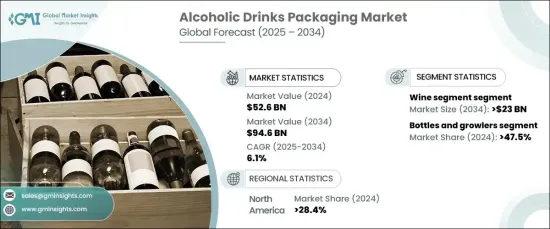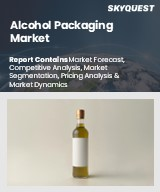
|
시장보고서
상품코드
1665203
세계의 알코올 음료 포장 시장(2025-2034년) : 시장 기회, 성장 촉진요인, 산업 동향 분석 및 예측Alcoholic Drinks Packaging Market Opportunity, Growth Drivers, Industry Trend Analysis, and Forecast 2025 - 2034 |
||||||
2024년에 526억 달러로 평가된 세계의 알코올 음료 포장 시장은 2025-2034년에 걸쳐 CAGR 6.1%라는 경이로운 성장을 이룰 것으로 예측하고 있습니다.
이 성장은 진화하는 소비자의 선호에 따라 혁신적이고 지속 가능한 친환경 포장 솔루션에 대한 수요가 증가하면서 뒷받침되고 있습니다. 제조업체는 환경 의식의 고조에 대응하기 위해, 재생 PET(rPET), 유리, 알루미늄 등 생태계에 대한 영향을 최소화하는 재료를 우선시하고 있습니다.

가벼우면서 쉽게 깨지지 않는 포장은 실용적인 요구와 생태 감수성 모두에 어필하면서 인기를 끌고 있습니다. 고급 알코올 음료와 특수 알코올 음료의 인기가 높아짐에 따라 포장 시장에서는 제품을 보호할뿐만 아니라 시각적 매력을 높이는 디자인에 대한 수요가 급증하고 있습니다. 스마트 라벨 및 증강현실(AR) 기능과 같은 첨단 기술의 통합은 시장을 더욱 변화시키고 포장을 소비자 경험의 필수적인 부분으로 자리매김합니다.
| 시장 범위 | |
|---|---|
| 시작년 | 2024년 |
| 예측연도 | 2025-2034년 |
| 시작금액 | 526억 달러 |
| 예측금액 | 946억 달러 |
| CAGR | 6.1% |
시장 세분화는 제품 유형별로 분류되며 병과 그라울러, 캔, 파우치, 배럴 및 기타 형식이 포함됩니다. 병과 그라울러는 2024년에 47.5%의 압도적인 점유율을 차지하였고, 그 원인으로는 주로 맥주, 와인, 증류주에 널리 사용되고 있는 점을 들 수 있습니다. 유리병은 고급스러운 외관, 내구성 및 재활용 가능성으로 인해 여전히 가장 유력한 후보이며, 그라울러는 재사용 가능한 옵션을 요구하는 환경 의식이 높은 소비자를 수용합니다. 이 부문은 음료의 맛과 무결성을 유지할뿐만 아니라 전반적인 경험을 향상시키는 포장에 대한 소비자의 기호 증가를 반영합니다.
최종 용도의 관점에서 시장은 맥주, 와인, 증류주 등으로 분류됩니다. 와인 부문이 가장 급성장을 기록하고 있으며 CAGR 7.1%로 성장하여 2034년에는 230억 달러에 이를 것으로 예상됩니다. 이 급성장의 배경에는 유기농, 바이오다이나믹, 지속 가능한 방법으로 생산된 와인에 대한 관심 증가와 프리미엄 상품을 선호하는 소비 패턴의 변화가 있습니다. 소비자는 가벼운 병과 재활용 재료를 사용한 라벨 등 지속 가능성을 중시한 혁신적인 포장 디자인에 매료되고 있습니다. 와인 산업에서는 환경친화적인 생산과 포장에 대한 주목이 높아지고 있으며, 프리미엄화와 지속 가능성으로의 전환이 강조되고 있습니다.
북미에서는 선진적이고 지속 가능한 포장 솔루션에 대한 높은 수요에 힘입어 알코올 음료 포장 시장은 2024년에 28.4%의 점유율을 획득했습니다. 이 지역에서는 크래프트 맥주와 스페셜티 와인을 포함한 프리미엄 알코올 음료 소비가 현저하게 증가하고 있으며, 따라서 혁신적인 포장 디자인의 채용이 촉진되고 있습니다. 기업은 편의성, 휴대성 및 환경에 대한 책임을 중시하는 현대 소비자를 수용하기 위해 재생 유리 및 경량 알루미늄과 같은 친환경 소재를 도입하고 있습니다. 이러한 동향은 세계 시장에서 북미가 혁신의 주요 촉진요인으로서의 역할을 담당하고 있음을 부각하고 있습니다.
목차
제1장 조사 방법 및 조사 범위
- 시장 범위 및 정의
- 기본 추정 및 계산
- 예측 계산
- 데이터 소스
- 1차 데이터
- 2차 자료
- 유료 정보원
- 공공 정보원
제2장 주요 요약
제3장 산업 인사이트
- 생태계 분석
- 밸류체인에 영향을 주는 요인
- 변혁
- 미래 전망
- 제조업체
- 유통업체
- 이익률 분석
- 주요 뉴스 및 대처
- 규제 상황
- 영향요인
- 성장 촉진요인
- 프리미엄 및 고급 알코올 음료 소비 증가
- 지속 가능하고 환경친화적인 포장에 대한 수요 증가
- 전자상거래에 의한 알코올 배송 채널 확대
- 알코올 음료의 세계적 소비 증가
- 보다 안전하고 표준화된 포장을 추진하는 규제 준수 요구
- 산업의 잠재적 리스크 및 과제
- 정부의 엄격한 규제 및 시책
- 지속 가능한 포장 솔루션의 높은 개발 비용
- 성장 촉진요인
- 성장 가능성 분석
- Porter's Five Forces 분석
- PESTEL 분석
제4장 경쟁 구도
- 소개
- 기업 점유율 분석
- 경쟁 포지셔닝 매트릭스
- 전략 전망 매트릭스
제5장 시장 추정 및 예측 : 제품별(2021-2034년)
- 주요 동향
- 병 및 그라울러
- 캔
- 파우치
- 배럴
- 기타
제6장 시장 추정 및 예측 : 재료별(2021-2034년)
- 주요 동향
- 플라스틱
- 유리
- 금속
- 목재
제7장 시장 추정 및 예측 : 최종 용도별(2021-2034년)
- 주요 동향
- 맥주
- 와인
- 증류주
- 기타
제8장 시장 추정 및 예측 : 지역별(2021-2034년)
- 주요 동향
- 북미
- 미국
- 캐나다
- 유럽
- 영국
- 독일
- 프랑스
- 이탈리아
- 스페인
- 러시아
- 아시아태평양
- 중국
- 인도
- 일본
- 한국
- 호주
- 라틴아메리카
- 브라질
- 멕시코
- 중동 및 아프리카
- 남아프리카
- 사우디아라비아
- 아랍에미리트(UAE)
제9장 기업 프로파일
- AGI Glaspac
- Amcor
- Ardagh Group
- Ball Corporation
- Berry Global
- Big Sky Packaging
- Crown Holdings
- DS Smith
- Encore Glass
- Glassworks International
- Golden West Packaging
- Graham Packaging Company
- Mondi
- OI Glass
- Orora Group
- PT Packaging
- Saxco International
- Sealed Air
- SIG Combibloc Group
- Smurfit Kappa
- Tetra Pak Group
- TricorBraun
- Verallia
- Vetreria Etrusca
- WestRock
The Global Alcoholic Drinks Packaging Market, valued at USD 52.6 billion in 2024, is projected to grow at an impressive CAGR of 6.1% from 2025 to 2034. This growth is fueled by the increasing demand for innovative, sustainable, and eco-friendly packaging solutions that align with evolving consumer preferences. Manufacturers are responding to the rising environmental consciousness by prioritizing materials like recycled PET (rPET), glass, and aluminum, which minimize ecological impact.

Lightweight and shatterproof packaging options are also gaining traction, appealing to both practical needs and ecological sensibilities. As premium and specialty alcoholic beverages continue to grow in popularity, the packaging market is witnessing a surge in demand for designs that not only protect the product but also enhance its visual appeal. The integration of advanced technology, such as smart labels and augmented reality features, is further revolutionizing the market, making packaging an integral part of the consumer experience.
| Market Scope | |
|---|---|
| Start Year | 2024 |
| Forecast Year | 2025-2034 |
| Start Value | $52.6 Billion |
| Forecast Value | $94.6 Billion |
| CAGR | 6.1% |
Segmented by product type, the market includes bottles and growlers, cans, pouches, barrels, and other formats. Bottles and growlers held a commanding 47.5% share in 2024, primarily driven by their widespread use across beer, wine, and spirits. Glass bottles remain a top choice due to their premium appearance, durability, and recyclability, while growlers cater to environmentally conscious consumers seeking reusable options. This segment reflects the growing consumer preference for packaging that not only preserves the flavor and integrity of beverages but also enhances their overall experience.
From an end-use perspective, the market is categorized into beer, wine, spirits, and others. The wine segment is expected to record the fastest growth, achieving a CAGR of 7.1% and reaching USD 23 billion by 2034. This surge is attributed to increasing interest in organic, biodynamic, and sustainably produced wines, coupled with changing consumption patterns favoring premium offerings. Consumers are gravitating toward innovative packaging designs that emphasize sustainability, such as lightweight bottles and labels made from recycled materials. The growing focus on eco-conscious production and packaging practices within the wine industry underscores the shift toward premiumization and sustainability.
In North America, the alcoholic drinks packaging market captured a 28.4% share in 2024, bolstered by robust demand for advanced, sustainable packaging solutions. The region is experiencing a notable rise in premium alcoholic beverages, including craft beers and specialty wines, prompting the adoption of innovative packaging designs. Companies are introducing eco-friendly materials like recycled glass and lightweight aluminum to cater to modern consumers who value convenience, portability, and environmental responsibility. These trends highlight North America's role as a key driver of innovation within the global market.
Table of Contents
Chapter 1 Methodology & Scope
- 1.1 Market scope & definitions
- 1.2 Base estimates & calculations
- 1.3 Forecast calculations
- 1.4 Data sources
- 1.4.1 Primary
- 1.4.2 Secondary
- 1.4.2.1 Paid sources
- 1.4.2.2 Public sources
Chapter 2 Executive Summary
- 2.1 Industry synopsis, 2021-2034
Chapter 3 Industry Insights
- 3.1 Industry ecosystem analysis
- 3.1.1 Factor affecting the value chain
- 3.1.2 Disruptions
- 3.1.3 Future outlook
- 3.1.4 Manufacturers
- 3.1.5 Distributors
- 3.2 Profit margin analysis
- 3.3 Key news & initiatives
- 3.4 Regulatory landscape
- 3.5 Impact forces
- 3.5.1 Growth drivers
- 3.5.1.1 Rise in premium and luxury alcoholic beverages
- 3.5.1.2 Growing demand for sustainable and eco-friendly packaging
- 3.5.1.3 Expansion of e-commerce alcohol delivery channels
- 3.5.1.4 Rising global consumption of alcoholic beverages
- 3.5.1.5 Regulatory compliance driving safer and standardized packaging
- 3.5.2 Industry pitfalls & challenges
- 3.5.2.1 Stringent government regulations and taxation policies
- 3.5.2.2 High costs of developing sustainable packaging solutions
- 3.5.1 Growth drivers
- 3.6 Growth potential analysis
- 3.7 Porter’s analysis
- 3.8 PESTEL analysis
Chapter 4 Competitive Landscape, 2024
- 4.1 Introduction
- 4.2 Company market share analysis
- 4.3 Competitive positioning matrix
- 4.4 Strategic outlook matrix
Chapter 5 Market Estimates & Forecast, By Product, 2021-2034 (USD Billion & Kilo Tons)
- 5.1 Key trends
- 5.2 Bottles and growlers
- 5.3 Cans
- 5.4 Pouches
- 5.5 Barrels
- 5.6 Others
Chapter 6 Market Estimates & Forecast, By Material, 2021-2034 (USD Billion & Kilo Tons)
- 6.1 Key trends
- 6.2 Plastic
- 6.3 Glass
- 6.4 Metal
- 6.5 Wood
Chapter 7 Market Estimates & Forecast, By End Use, 2021-2034 (USD Billion & Kilo Tons)
- 7.1 Key trends
- 7.2 Beer
- 7.3 Wine
- 7.4 Spirit
- 7.5 Other
Chapter 8 Market Estimates & Forecast, By Region, 2021-2034 (USD Billion & Kilo Tons)
- 8.1 Key trends
- 8.2 North America
- 8.2.1 U.S.
- 8.2.2 Canada
- 8.3 Europe
- 8.3.1 UK
- 8.3.2 Germany
- 8.3.3 France
- 8.3.4 Italy
- 8.3.5 Spain
- 8.3.6 Russia
- 8.4 Asia Pacific
- 8.4.1 China
- 8.4.2 India
- 8.4.3 Japan
- 8.4.4 South Korea
- 8.4.5 Australia
- 8.5 Latin America
- 8.5.1 Brazil
- 8.5.2 Mexico
- 8.6 MEA
- 8.6.1 South Africa
- 8.6.2 Saudi Arabia
- 8.6.3 UAE
Chapter 9 Company Profiles
- 9.1 AGI Glaspac
- 9.2 Amcor
- 9.3 Ardagh Group
- 9.4 Ball Corporation
- 9.5 Berry Global
- 9.6 Big Sky Packaging
- 9.7 Crown Holdings
- 9.8 DS Smith
- 9.9 Encore Glass
- 9.10 Glassworks International
- 9.11 Golden West Packaging
- 9.12 Graham Packaging Company
- 9.13 Mondi
- 9.14 O-I Glass
- 9.15 Orora Group
- 9.16 PT Packaging
- 9.17 Saxco International
- 9.18 Sealed Air
- 9.19 SIG Combibloc Group
- 9.20 Smurfit Kappa
- 9.21 Tetra Pak Group
- 9.22 TricorBraun
- 9.23 Verallia
- 9.24 Vetreria Etrusca
- 9.25 WestRock



















